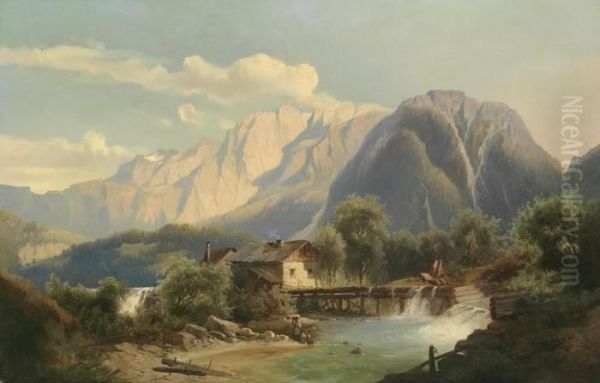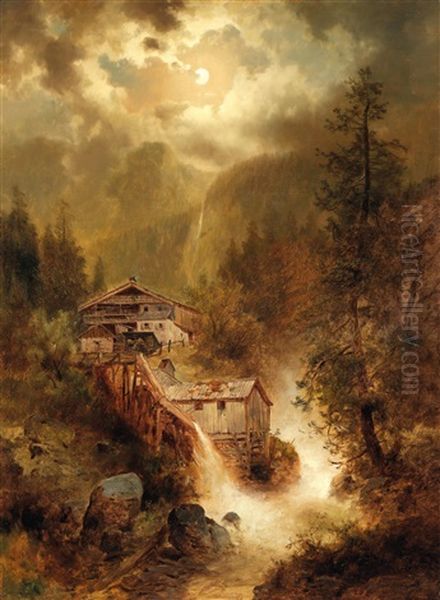Josef Thoma stands as a notable figure in Austrian art history, primarily recognized for his evocative landscape paintings created during the late 19th and early 20th centuries. Born in 1850 and passing away in 1926, his life spanned a period of significant artistic transition in Europe. While detailed biographical records remain somewhat scarce, his body of work provides compelling insight into his artistic vision, technical skill, and deep appreciation for the natural world, particularly the majestic scenery of the Austrian Alps.
It is important at the outset to distinguish this Josef Thoma (1850-1926) from another Austrian landscape painter also named Josef Thoma, who lived from 1828 to 1899. The similarity in names and profession has occasionally led to confusion, but their distinct life dates and potentially subtle stylistic differences mark them as separate individuals within the Austrian art tradition. This exploration focuses specifically on the artist active into the early 20th century.
Artistic Formation and Influences
Information regarding Josef Thoma's formal artistic training is limited in the available sources. However, it is noted that he likely pursued studies in Vienna, possibly at the prestigious Academy of Fine Arts, a common path for aspiring Austrian artists of his time. Vienna, as the heart of the Austro-Hungarian Empire, offered a rich cultural environment and access to significant artistic trends and collections, which would have undoubtedly shaped his development.
A key influence cited on Thoma's work is the German Romantic painter Caspar David Friedrich (1774-1840). Although Friedrich belonged to an earlier generation, his profound impact on landscape painting, emphasizing nature's spiritual and sublime qualities, resonated throughout the 19th century. Thoma's adoption of Romantic sensibilities is evident in the mood and atmosphere he often captured, portraying nature not just as a physical entity but as a source of awe and emotional reflection. This connection places Thoma within a lineage of artists who saw landscape as a vehicle for deeper meaning.

While direct mentorship records are absent, Thoma would have been aware of the prevailing artistic currents of his time, including the lingering influence of Romanticism, the rise of Realism and Naturalism, and the burgeoning Impressionist movements elsewhere in Europe. His work seems to synthesize elements of Romantic feeling with a Naturalistic attention to detail, suggesting an artist who absorbed contemporary trends while forging his own distinct path.
Style and Thematic Focus
Josef Thoma dedicated his artistic career primarily to landscape painting, demonstrating a particular affinity for the dramatic vistas of the Alps, the serene beauty of the Danube River valley, and the picturesque rural scenery found in regions like Tyrol and the areas surrounding Salzburg. His chosen medium was often oil on canvas or panel, though he also worked proficiently in watercolor, showcasing versatility in his technical approach.
His style is characterized by a blend of Romanticism and Naturalism. The Romantic influence is apparent in his frequent depiction of imposing mountains, deep valleys, and the often-untamed aspects of nature, evoking feelings of grandeur and sometimes solitude. He sought to capture the "pure" and "raw" beauty of the landscape, presenting scenes often untouched by extensive human intervention, emphasizing the power and majesty of the natural world.
Simultaneously, Thoma incorporated elements of Naturalism through his meticulous attention to detail. His works often feature carefully rendered trees, rocks, water, and atmospheric effects. There is an emphasis on the accurate depiction of flora and fauna within their natural habitats, grounding the Romantic sensibility in observable reality. This careful observation suggests an artist who spent considerable time directly engaging with the landscapes he painted. Some sources also suggest a possible influence from German woodcut traditions, perhaps reflected in the expressive quality or richness of color in certain works, although landscape painting remained his primary focus.
Notable Works
Several specific works help illustrate Josef Thoma's artistic output and thematic concerns. While a comprehensive catalogue raisonné might be lacking, certain paintings stand out:
One frequently mentioned piece is "House in the Alps." This painting exemplifies his focus on Alpine scenery and likely captures the characteristic architecture nestled within the mountainous terrain. Its inclusion in the collection of the Art Palace of Georgia (Georgian National Museum) and subsequent restoration highlights its perceived artistic value and Thoma's international reach, however limited.

"Górski potok" (Mountain Stream) is another significant work, executed in oil on panel or canvas (sources vary slightly) with dimensions of 70 x 105 cm. Signed by the artist, its creation date is sometimes placed in the 1920s, which would make it a very late work, created shortly before his death in 1926. This painting likely showcases his skill in depicting moving water and rugged terrain, common motifs in his oeuvre.
A watercolor titled "Waterfall in the Mountains," measuring 50 x 37 cm and signed, is dated around 1880 in some sources. This work demonstrates his ability in a different medium, capturing the dynamic energy of a waterfall. However, it's crucial to note some conflicting information arises in the source material, with one reference attributing a similarly titled work from 1870 to the German-American painter Albert Bierstadt. Without visual confirmation or further provenance research, attributing this specific watercolor definitively requires caution, though the c. 1880 date aligns well with Thoma's active period.
"St. Michael, Donau," a watercolor measuring 24.7 x 35.4 cm, is dated to circa 1870. This piece indicates his interest extended beyond the high Alps to the landscapes along the vital Danube River. It likely captures a specific location, St. Michael, possibly in the Wachau valley, known for its scenic beauty. While the exact year isn't pinpointed, the circa 1870 date places it relatively early in his known career.
Another generically titled work, "A Mountainous River Landscape," further reinforces his commitment to depicting the interplay of water and mountains, emphasizing the raw, pristine elements of the natural world that clearly captivated him throughout his career.
Context: Contemporaries and the Artistic Milieu
Josef Thoma worked during a vibrant period in Central European art. While direct records of his interactions with specific contemporaries are scarce, he was part of a broader artistic landscape populated by numerous talented individuals. Understanding this context helps situate his contributions.
In Austria itself, landscape painting flourished. Artists like Emil Jakob Schindler (1842-1892), a leading figure in Austrian Mood Impressionism (Stimmungsimpressionismus), explored atmospheric effects and lyrical depictions of local scenery. Tina Blau (1845-1916) and Olga Wisinger-Florian (1844-1926), both prominent female artists, also made significant contributions to landscape and floral painting, often working en plein air. Though perhaps stylistically different, their shared focus on Austrian landscapes places them within Thoma's milieu. Anton Romako (1832-1889), known for his eccentric portraits and historical scenes, represents a different facet of Viennese art during Thoma's earlier career. The long-lived Rudolf von Alt (1812-1905) continued to produce detailed cityscapes and landscapes well into Thoma's active period.

Looking towards Germany, the influence of Romanticism persisted alongside strong Realist trends. Hans Thoma (1839-1924) – importantly, not Josef Thoma, despite the shared surname – was a major German painter associated with Realism and Symbolism, often depicting idyllic Black Forest scenes. Wilhelm Leibl (1844-1900) was a key figure in German Realism. The Achenbach brothers, Andreas (1815-1910) and Oswald (1827-1905), were highly successful landscape painters of the Düsseldorf school, known for their dramatic seascapes and Italian scenes, respectively. Carl Spitzweg (1808-1885), though slightly earlier, captured Biedermeier life with gentle irony, often including landscape elements. The Swiss-German Arnold Böcklin (1827-1901), famous for his mythological scenes like "Isle of the Dead," was a major figure whose influence stretched across Europe.
Further afield, landscape painting was evolving rapidly. The aforementioned Albert Bierstadt (1830-1902), known for his monumental paintings of the American West, shared an interest in sublime mountain scenery, albeit on a different continent and often on a grander scale. In Russia, Ivan Shishkin (1832-1898) was a master of forest landscapes within the Realist tradition.
The Polish artists Wojciech Kossak (1856-1942), famed for his historical and equestrian paintings, and Władysław Jarocki (1879-1965), known for his depictions of Hutsul folk life, were also contemporaries mentioned in the source material. While their primary subjects differed from Thoma's Alpine focus, they were part of the broader Central and Eastern European art scene of the time. Although no specific collaborations or direct interactions between Josef Thoma and these individuals are documented, their concurrent activities highlight the diverse artistic environment in which he worked. Thoma carved his niche by focusing intently on the Austrian landscape, rendered with a blend of Romantic feeling and Naturalistic detail.
Clarifying Identities: Other Josef Thomas
The existence of other notable individuals named Josef Thoma necessitates careful distinction to avoid biographical confusion. As previously mentioned, the most significant potential mix-up is with the other Austrian landscape painter, Josef Thoma (1828-1899). This artist was also active in Vienna and focused on similar subject matter, making differentiation crucial, primarily based on their distinct lifespans (1828-1899 vs. 1850-1926).
Another prominent figure was Ludwig Thoma (1867-1921), a well-known German author, playwright, and publisher, famous for his satirical writings about Bavarian life and his work with the magazine Simplicissimus. He belongs to the world of literature, entirely separate from Josef Thoma the painter.
Historical records also mention a Josef Thoma who established a printing house in Munich in 1870. This individual operated in the graphic arts and printing industry, distinct from fine art painting.
Furthermore, one source snippet confusingly links a Josef Thoma with the founding of Westfalia Jagdreisen, a company focused on sustainable hunting tourism, and investments in Asia. Given the timeline and the vastly different field of activity, it is extremely unlikely that this refers to the landscape painter Josef Thoma (1850-1926). This almost certainly pertains to a different person entirely, perhaps of a later generation, who happens to share the name. It is vital not to conflate the activities of this businessman with the life and work of the Austrian artist.
Legacy and Collections
Josef Thoma's legacy rests on his contribution to the Austrian landscape painting tradition. He captured the specific topography and atmosphere of the Alps and Danube regions with skill and sensitivity. While perhaps not an innovator who radically altered the course of art history, he was a dedicated and proficient artist who produced a significant body of work appreciated for its beauty and technical execution. His paintings offer viewers a glimpse into the Austrian landscape as perceived through a late Romantic and Naturalist lens.
His works are held in several public collections, attesting to their enduring appeal. Key institutions include the Vienna Museum (Wien Museum), which holds significant collections related to the city's history and culture, and the Albertina in Vienna, renowned for its vast collection of prints and drawings but also holding paintings. The presence of "House in the Alps" in the Art Palace of Georgia (Georgian National Museum) in Tbilisi indicates that his work also found its way into international collections.
In conclusion, Josef Thoma (1850-1926) was a dedicated Austrian painter specializing in landscapes, particularly the Alps. Working within the traditions of Romanticism and Naturalism, he created detailed and evocative scenes that celebrated the majesty and beauty of the natural world. Though biographical details are sparse and potential confusion with namesakes exists, his surviving works in collections like the Vienna Museum, Albertina, and the Art Palace of Georgia secure his place as a noteworthy artist within the rich tapestry of late 19th and early 20th-century Austrian art. His paintings continue to offer viewers compelling visions of the Austrian landscape.